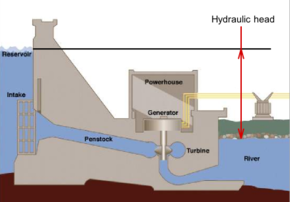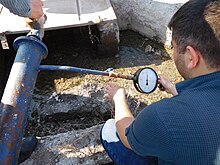
Back Càrrega hidràulica Catalan Тапăм CV Fallhöhe (Wasserbau) German Falalto (akvokonstruo) Esperanto Cabezal hidráulico Spanish Putouskorkeus Finnish Charge (hydraulique) French עומד הידראולי HE Tinggi tekan hidraulik ID Quota piezometrica Italian
This article has multiple issues. Please help improve it or discuss these issues on the talk page. (Learn how and when to remove these messages)
|



Hydraulic head or piezometric head is a specific measurement of liquid pressure above a vertical datum.[1][2]
It is usually measured as a liquid surface elevation, expressed in units of length, at the entrance (or bottom) of a piezometer. In an aquifer, it can be calculated from the depth to water in a piezometric well (a specialized water well), and given information of the piezometer's elevation and screen depth. Hydraulic head can similarly be measured in a column of water using a standpipe piezometer by measuring the height of the water surface in the tube relative to a common datum. The hydraulic head can be used to determine a hydraulic gradient between two or more points.
- ^ Mulley, Raymond (2004), Flow of Industrial Fluids: Theory and Equations, CRC Press, ISBN 978-0849327674, 410 pages. See pp. 43–44.
- ^ Chanson, Hubert (2004), Hydraulics of Open Channel Flow: An Introduction, Butterworth–Heinemann, ISBN 978-0750659789, 650 pages. See p. 22.